Analysis of Impairment of Assets and IAS 36 Accounting Standard
VerifiedAdded on 2020/03/04
|7
|2062
|48
Report
AI Summary
This report provides a comprehensive analysis of asset impairment, focusing on the IAS 36 accounting standard. Part A delves into the recognition and measurement of impairment losses for individual assets, defining key terms like carrying amount, recoverable amount, fair value, and value in use. It outlines the objective of IAS 36, which is to help organizations identify and account for damaged assets, ensuring assets are not valued higher than their recoverable amount. Part B presents a practical application of the standard, demonstrating the calculation of impairment losses for a Cash-Generating Unit (CGU), including the allocation of impairment to goodwill, plant, equipment, and fittings, and calculating the adjusted carrying values of these assets. The report includes journal entries to record the impairment loss and references to relevant accounting literature.
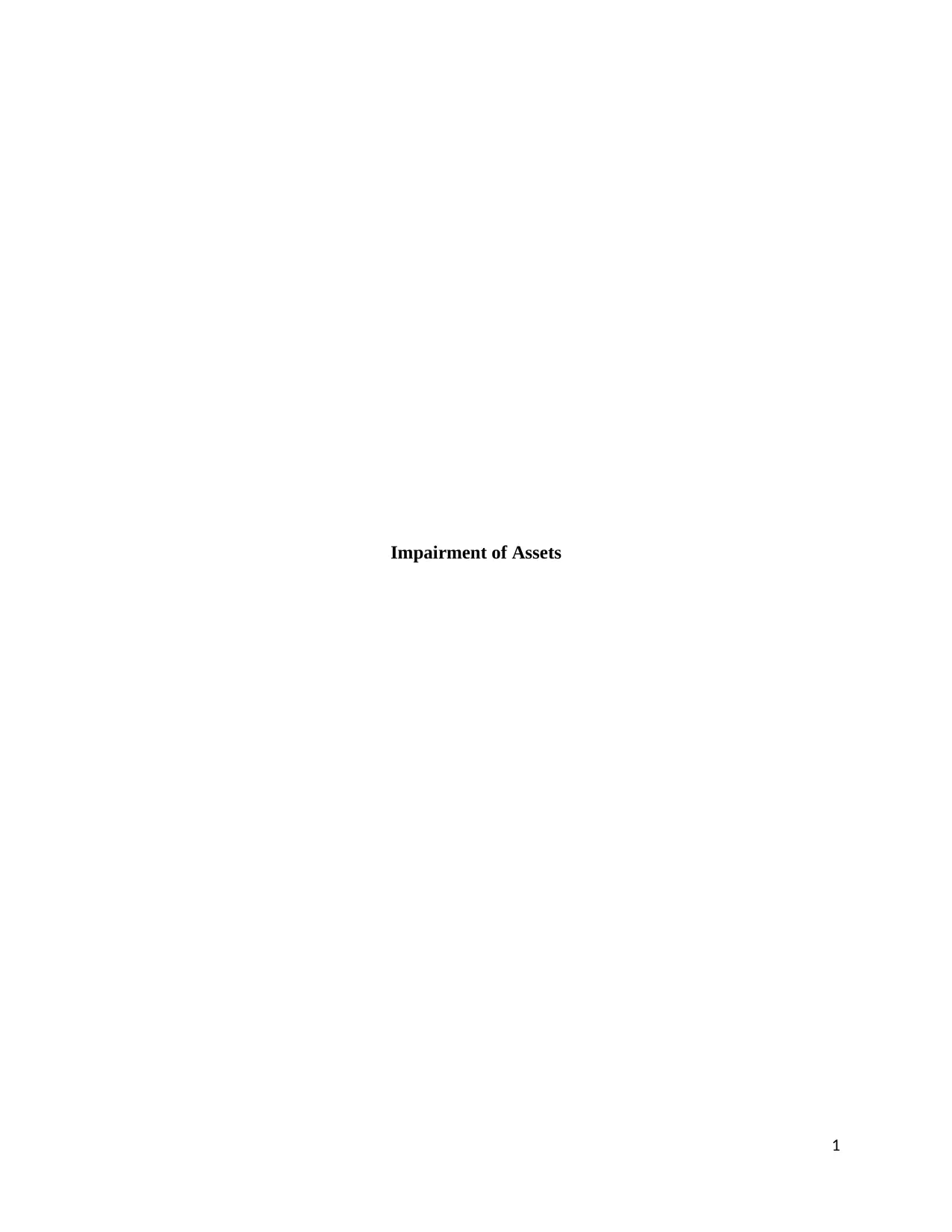
Impairment of Assets
1
1
Paraphrase This Document
Need a fresh take? Get an instant paraphrase of this document with our AI Paraphraser
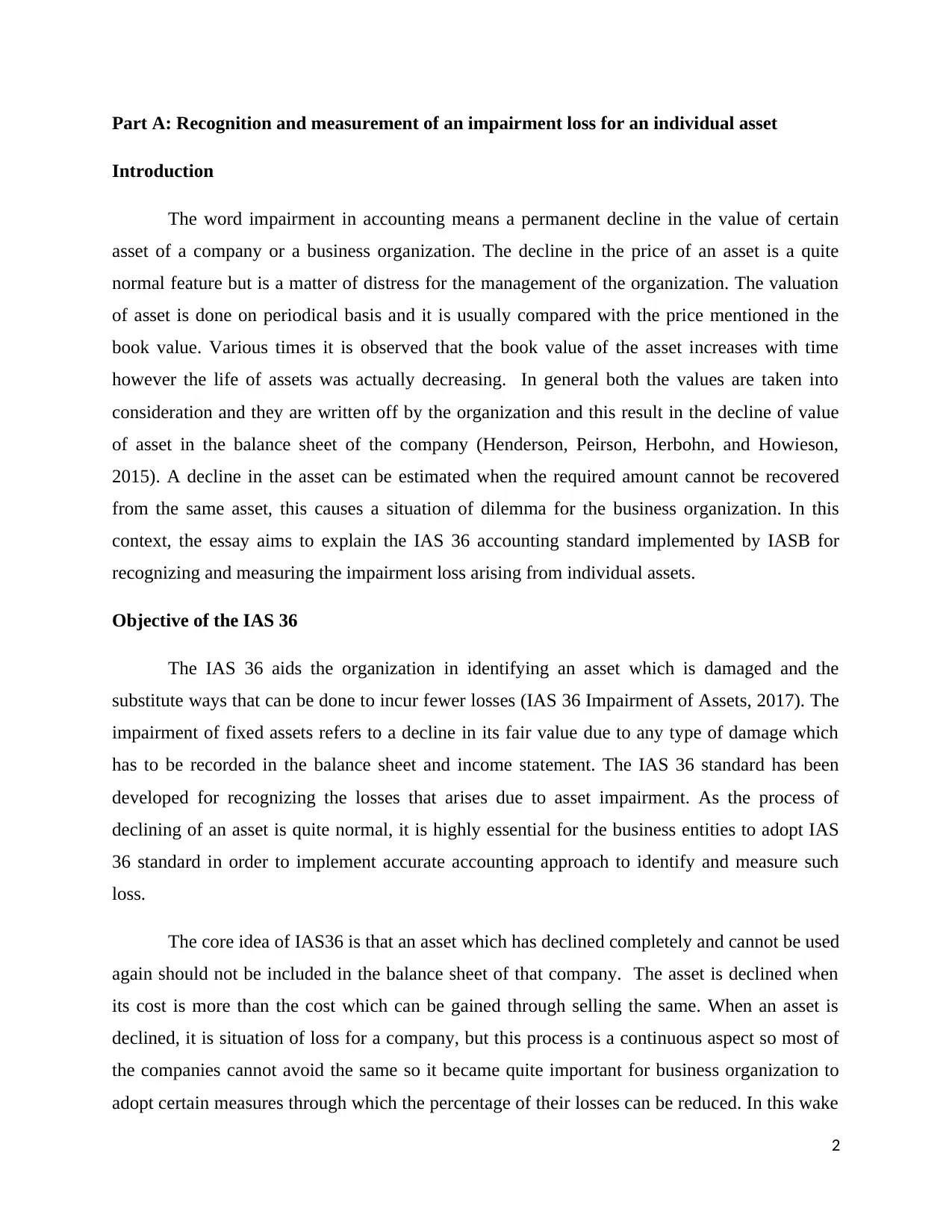
Part A: Recognition and measurement of an impairment loss for an individual asset
Introduction
The word impairment in accounting means a permanent decline in the value of certain
asset of a company or a business organization. The decline in the price of an asset is a quite
normal feature but is a matter of distress for the management of the organization. The valuation
of asset is done on periodical basis and it is usually compared with the price mentioned in the
book value. Various times it is observed that the book value of the asset increases with time
however the life of assets was actually decreasing. In general both the values are taken into
consideration and they are written off by the organization and this result in the decline of value
of asset in the balance sheet of the company (Henderson, Peirson, Herbohn, and Howieson,
2015). A decline in the asset can be estimated when the required amount cannot be recovered
from the same asset, this causes a situation of dilemma for the business organization. In this
context, the essay aims to explain the IAS 36 accounting standard implemented by IASB for
recognizing and measuring the impairment loss arising from individual assets.
Objective of the IAS 36
The IAS 36 aids the organization in identifying an asset which is damaged and the
substitute ways that can be done to incur fewer losses (IAS 36 Impairment of Assets, 2017). The
impairment of fixed assets refers to a decline in its fair value due to any type of damage which
has to be recorded in the balance sheet and income statement. The IAS 36 standard has been
developed for recognizing the losses that arises due to asset impairment. As the process of
declining of an asset is quite normal, it is highly essential for the business entities to adopt IAS
36 standard in order to implement accurate accounting approach to identify and measure such
loss.
The core idea of IAS36 is that an asset which has declined completely and cannot be used
again should not be included in the balance sheet of that company. The asset is declined when
its cost is more than the cost which can be gained through selling the same. When an asset is
declined, it is situation of loss for a company, but this process is a continuous aspect so most of
the companies cannot avoid the same so it became quite important for business organization to
adopt certain measures through which the percentage of their losses can be reduced. In this wake
2
Introduction
The word impairment in accounting means a permanent decline in the value of certain
asset of a company or a business organization. The decline in the price of an asset is a quite
normal feature but is a matter of distress for the management of the organization. The valuation
of asset is done on periodical basis and it is usually compared with the price mentioned in the
book value. Various times it is observed that the book value of the asset increases with time
however the life of assets was actually decreasing. In general both the values are taken into
consideration and they are written off by the organization and this result in the decline of value
of asset in the balance sheet of the company (Henderson, Peirson, Herbohn, and Howieson,
2015). A decline in the asset can be estimated when the required amount cannot be recovered
from the same asset, this causes a situation of dilemma for the business organization. In this
context, the essay aims to explain the IAS 36 accounting standard implemented by IASB for
recognizing and measuring the impairment loss arising from individual assets.
Objective of the IAS 36
The IAS 36 aids the organization in identifying an asset which is damaged and the
substitute ways that can be done to incur fewer losses (IAS 36 Impairment of Assets, 2017). The
impairment of fixed assets refers to a decline in its fair value due to any type of damage which
has to be recorded in the balance sheet and income statement. The IAS 36 standard has been
developed for recognizing the losses that arises due to asset impairment. As the process of
declining of an asset is quite normal, it is highly essential for the business entities to adopt IAS
36 standard in order to implement accurate accounting approach to identify and measure such
loss.
The core idea of IAS36 is that an asset which has declined completely and cannot be used
again should not be included in the balance sheet of that company. The asset is declined when
its cost is more than the cost which can be gained through selling the same. When an asset is
declined, it is situation of loss for a company, but this process is a continuous aspect so most of
the companies cannot avoid the same so it became quite important for business organization to
adopt certain measures through which the percentage of their losses can be reduced. In this wake
2
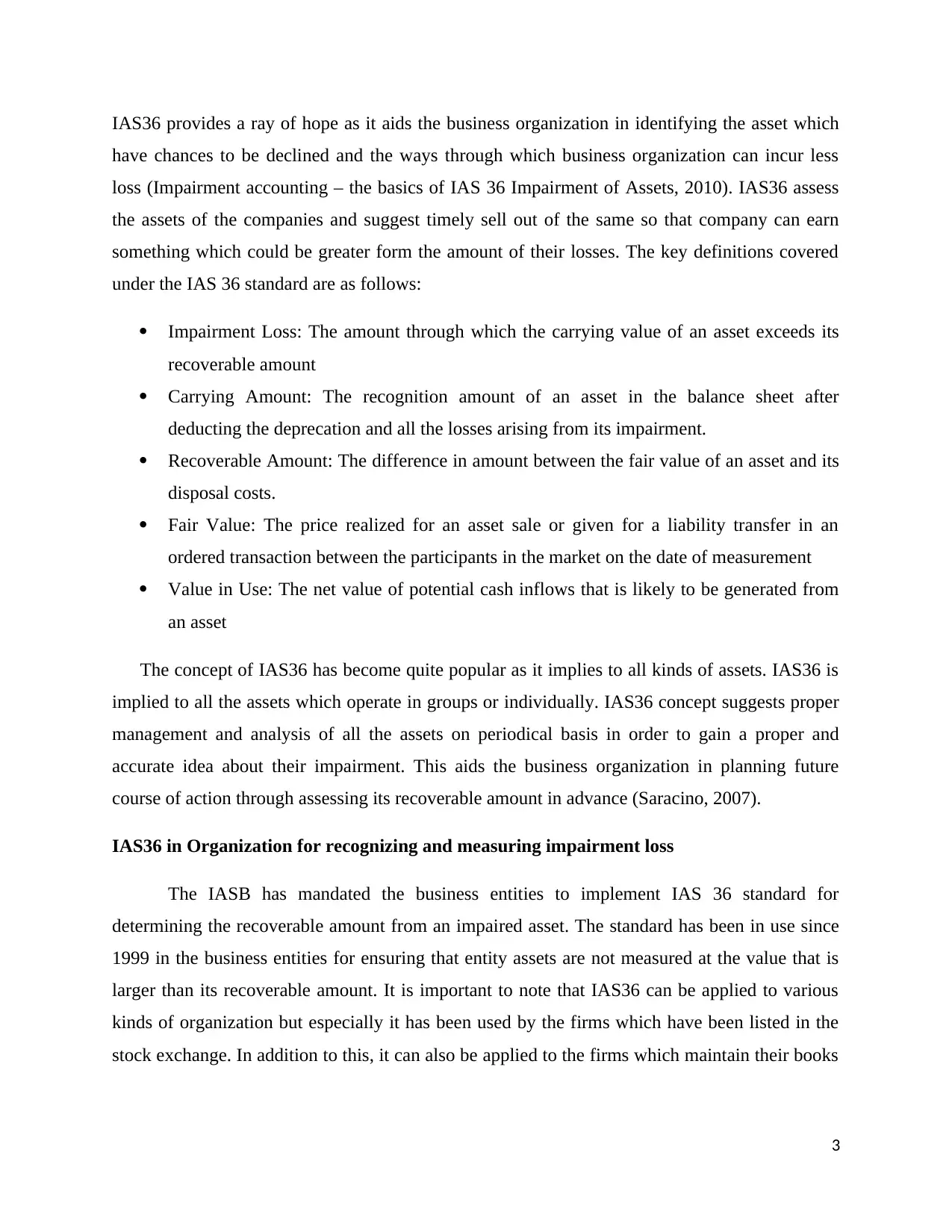
IAS36 provides a ray of hope as it aids the business organization in identifying the asset which
have chances to be declined and the ways through which business organization can incur less
loss (Impairment accounting – the basics of IAS 36 Impairment of Assets, 2010). IAS36 assess
the assets of the companies and suggest timely sell out of the same so that company can earn
something which could be greater form the amount of their losses. The key definitions covered
under the IAS 36 standard are as follows:
Impairment Loss: The amount through which the carrying value of an asset exceeds its
recoverable amount
Carrying Amount: The recognition amount of an asset in the balance sheet after
deducting the deprecation and all the losses arising from its impairment.
Recoverable Amount: The difference in amount between the fair value of an asset and its
disposal costs.
Fair Value: The price realized for an asset sale or given for a liability transfer in an
ordered transaction between the participants in the market on the date of measurement
Value in Use: The net value of potential cash inflows that is likely to be generated from
an asset
The concept of IAS36 has become quite popular as it implies to all kinds of assets. IAS36 is
implied to all the assets which operate in groups or individually. IAS36 concept suggests proper
management and analysis of all the assets on periodical basis in order to gain a proper and
accurate idea about their impairment. This aids the business organization in planning future
course of action through assessing its recoverable amount in advance (Saracino, 2007).
IAS36 in Organization for recognizing and measuring impairment loss
The IASB has mandated the business entities to implement IAS 36 standard for
determining the recoverable amount from an impaired asset. The standard has been in use since
1999 in the business entities for ensuring that entity assets are not measured at the value that is
larger than its recoverable amount. It is important to note that IAS36 can be applied to various
kinds of organization but especially it has been used by the firms which have been listed in the
stock exchange. In addition to this, it can also be applied to the firms which maintain their books
3
have chances to be declined and the ways through which business organization can incur less
loss (Impairment accounting – the basics of IAS 36 Impairment of Assets, 2010). IAS36 assess
the assets of the companies and suggest timely sell out of the same so that company can earn
something which could be greater form the amount of their losses. The key definitions covered
under the IAS 36 standard are as follows:
Impairment Loss: The amount through which the carrying value of an asset exceeds its
recoverable amount
Carrying Amount: The recognition amount of an asset in the balance sheet after
deducting the deprecation and all the losses arising from its impairment.
Recoverable Amount: The difference in amount between the fair value of an asset and its
disposal costs.
Fair Value: The price realized for an asset sale or given for a liability transfer in an
ordered transaction between the participants in the market on the date of measurement
Value in Use: The net value of potential cash inflows that is likely to be generated from
an asset
The concept of IAS36 has become quite popular as it implies to all kinds of assets. IAS36 is
implied to all the assets which operate in groups or individually. IAS36 concept suggests proper
management and analysis of all the assets on periodical basis in order to gain a proper and
accurate idea about their impairment. This aids the business organization in planning future
course of action through assessing its recoverable amount in advance (Saracino, 2007).
IAS36 in Organization for recognizing and measuring impairment loss
The IASB has mandated the business entities to implement IAS 36 standard for
determining the recoverable amount from an impaired asset. The standard has been in use since
1999 in the business entities for ensuring that entity assets are not measured at the value that is
larger than its recoverable amount. It is important to note that IAS36 can be applied to various
kinds of organization but especially it has been used by the firms which have been listed in the
stock exchange. In addition to this, it can also be applied to the firms which maintain their books
3
⊘ This is a preview!⊘
Do you want full access?
Subscribe today to unlock all pages.

Trusted by 1+ million students worldwide
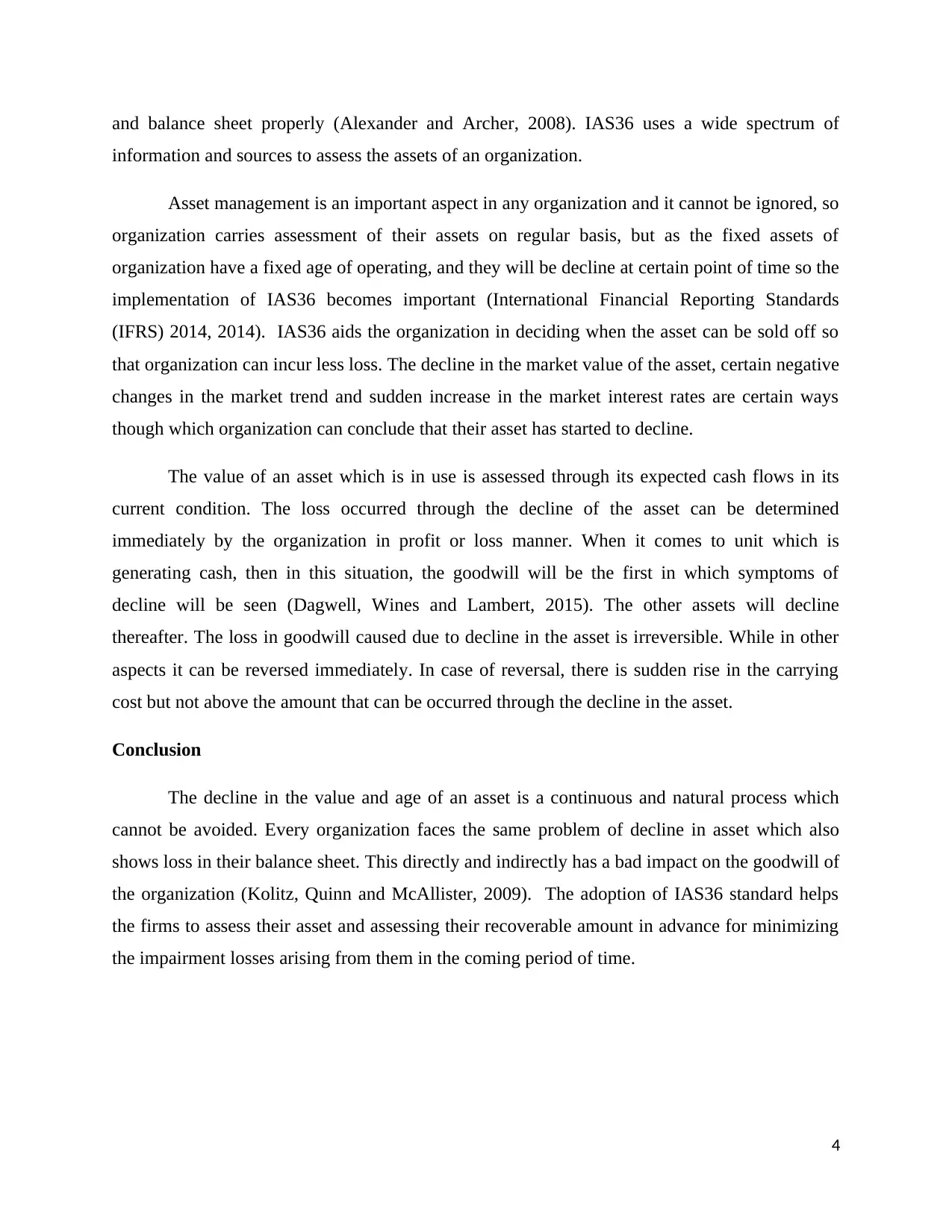
and balance sheet properly (Alexander and Archer, 2008). IAS36 uses a wide spectrum of
information and sources to assess the assets of an organization.
Asset management is an important aspect in any organization and it cannot be ignored, so
organization carries assessment of their assets on regular basis, but as the fixed assets of
organization have a fixed age of operating, and they will be decline at certain point of time so the
implementation of IAS36 becomes important (International Financial Reporting Standards
(IFRS) 2014, 2014). IAS36 aids the organization in deciding when the asset can be sold off so
that organization can incur less loss. The decline in the market value of the asset, certain negative
changes in the market trend and sudden increase in the market interest rates are certain ways
though which organization can conclude that their asset has started to decline.
The value of an asset which is in use is assessed through its expected cash flows in its
current condition. The loss occurred through the decline of the asset can be determined
immediately by the organization in profit or loss manner. When it comes to unit which is
generating cash, then in this situation, the goodwill will be the first in which symptoms of
decline will be seen (Dagwell, Wines and Lambert, 2015). The other assets will decline
thereafter. The loss in goodwill caused due to decline in the asset is irreversible. While in other
aspects it can be reversed immediately. In case of reversal, there is sudden rise in the carrying
cost but not above the amount that can be occurred through the decline in the asset.
Conclusion
The decline in the value and age of an asset is a continuous and natural process which
cannot be avoided. Every organization faces the same problem of decline in asset which also
shows loss in their balance sheet. This directly and indirectly has a bad impact on the goodwill of
the organization (Kolitz, Quinn and McAllister, 2009). The adoption of IAS36 standard helps
the firms to assess their asset and assessing their recoverable amount in advance for minimizing
the impairment losses arising from them in the coming period of time.
4
information and sources to assess the assets of an organization.
Asset management is an important aspect in any organization and it cannot be ignored, so
organization carries assessment of their assets on regular basis, but as the fixed assets of
organization have a fixed age of operating, and they will be decline at certain point of time so the
implementation of IAS36 becomes important (International Financial Reporting Standards
(IFRS) 2014, 2014). IAS36 aids the organization in deciding when the asset can be sold off so
that organization can incur less loss. The decline in the market value of the asset, certain negative
changes in the market trend and sudden increase in the market interest rates are certain ways
though which organization can conclude that their asset has started to decline.
The value of an asset which is in use is assessed through its expected cash flows in its
current condition. The loss occurred through the decline of the asset can be determined
immediately by the organization in profit or loss manner. When it comes to unit which is
generating cash, then in this situation, the goodwill will be the first in which symptoms of
decline will be seen (Dagwell, Wines and Lambert, 2015). The other assets will decline
thereafter. The loss in goodwill caused due to decline in the asset is irreversible. While in other
aspects it can be reversed immediately. In case of reversal, there is sudden rise in the carrying
cost but not above the amount that can be occurred through the decline in the asset.
Conclusion
The decline in the value and age of an asset is a continuous and natural process which
cannot be avoided. Every organization faces the same problem of decline in asset which also
shows loss in their balance sheet. This directly and indirectly has a bad impact on the goodwill of
the organization (Kolitz, Quinn and McAllister, 2009). The adoption of IAS36 standard helps
the firms to assess their asset and assessing their recoverable amount in advance for minimizing
the impairment losses arising from them in the coming period of time.
4
Paraphrase This Document
Need a fresh take? Get an instant paraphrase of this document with our AI Paraphraser
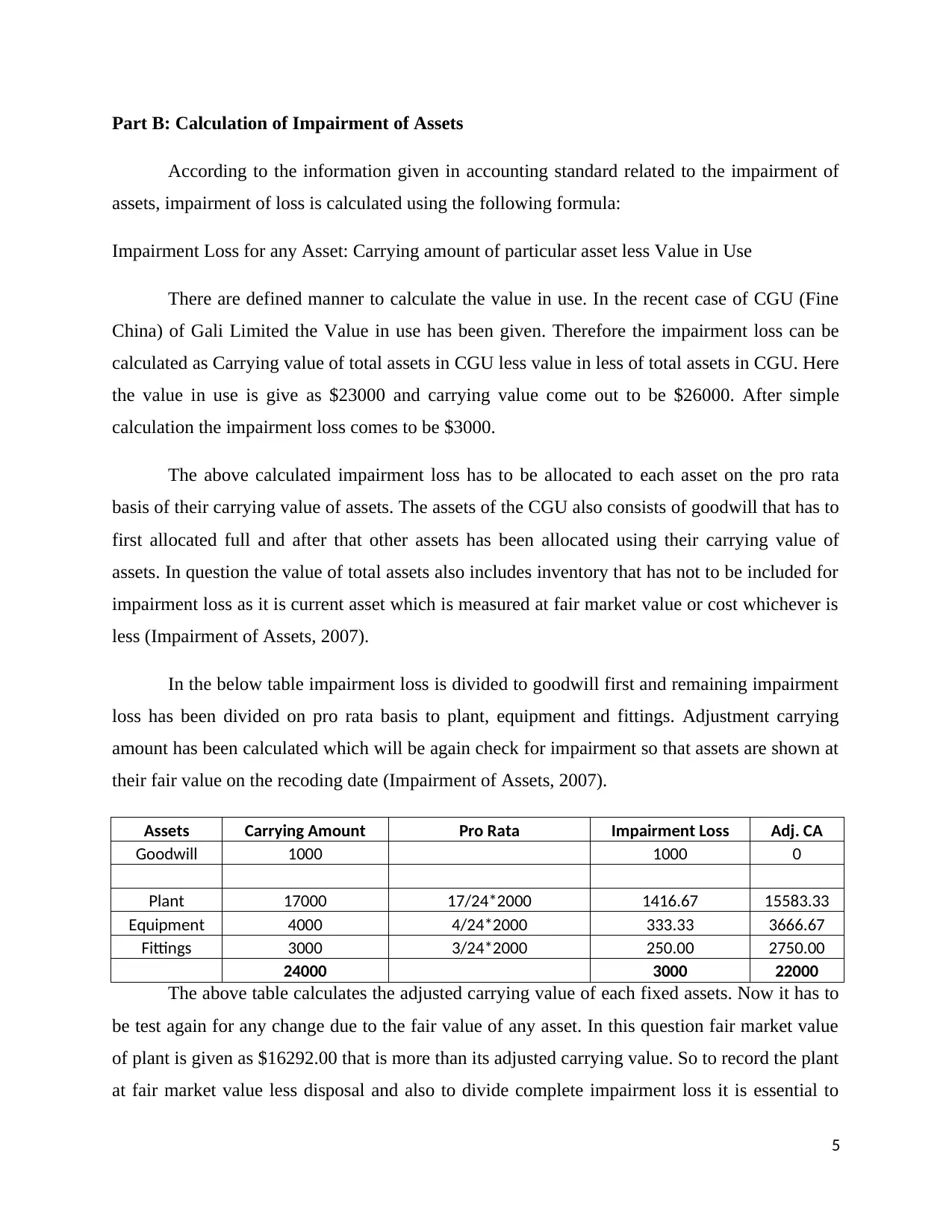
Part B: Calculation of Impairment of Assets
According to the information given in accounting standard related to the impairment of
assets, impairment of loss is calculated using the following formula:
Impairment Loss for any Asset: Carrying amount of particular asset less Value in Use
There are defined manner to calculate the value in use. In the recent case of CGU (Fine
China) of Gali Limited the Value in use has been given. Therefore the impairment loss can be
calculated as Carrying value of total assets in CGU less value in less of total assets in CGU. Here
the value in use is give as $23000 and carrying value come out to be $26000. After simple
calculation the impairment loss comes to be $3000.
The above calculated impairment loss has to be allocated to each asset on the pro rata
basis of their carrying value of assets. The assets of the CGU also consists of goodwill that has to
first allocated full and after that other assets has been allocated using their carrying value of
assets. In question the value of total assets also includes inventory that has not to be included for
impairment loss as it is current asset which is measured at fair market value or cost whichever is
less (Impairment of Assets, 2007).
In the below table impairment loss is divided to goodwill first and remaining impairment
loss has been divided on pro rata basis to plant, equipment and fittings. Adjustment carrying
amount has been calculated which will be again check for impairment so that assets are shown at
their fair value on the recoding date (Impairment of Assets, 2007).
Assets Carrying Amount Pro Rata Impairment Loss Adj. CA
Goodwill 1000 1000 0
Plant 17000 17/24*2000 1416.67 15583.33
Equipment 4000 4/24*2000 333.33 3666.67
Fittings 3000 3/24*2000 250.00 2750.00
24000 3000 22000
The above table calculates the adjusted carrying value of each fixed assets. Now it has to
be test again for any change due to the fair value of any asset. In this question fair market value
of plant is given as $16292.00 that is more than its adjusted carrying value. So to record the plant
at fair market value less disposal and also to divide complete impairment loss it is essential to
5
According to the information given in accounting standard related to the impairment of
assets, impairment of loss is calculated using the following formula:
Impairment Loss for any Asset: Carrying amount of particular asset less Value in Use
There are defined manner to calculate the value in use. In the recent case of CGU (Fine
China) of Gali Limited the Value in use has been given. Therefore the impairment loss can be
calculated as Carrying value of total assets in CGU less value in less of total assets in CGU. Here
the value in use is give as $23000 and carrying value come out to be $26000. After simple
calculation the impairment loss comes to be $3000.
The above calculated impairment loss has to be allocated to each asset on the pro rata
basis of their carrying value of assets. The assets of the CGU also consists of goodwill that has to
first allocated full and after that other assets has been allocated using their carrying value of
assets. In question the value of total assets also includes inventory that has not to be included for
impairment loss as it is current asset which is measured at fair market value or cost whichever is
less (Impairment of Assets, 2007).
In the below table impairment loss is divided to goodwill first and remaining impairment
loss has been divided on pro rata basis to plant, equipment and fittings. Adjustment carrying
amount has been calculated which will be again check for impairment so that assets are shown at
their fair value on the recoding date (Impairment of Assets, 2007).
Assets Carrying Amount Pro Rata Impairment Loss Adj. CA
Goodwill 1000 1000 0
Plant 17000 17/24*2000 1416.67 15583.33
Equipment 4000 4/24*2000 333.33 3666.67
Fittings 3000 3/24*2000 250.00 2750.00
24000 3000 22000
The above table calculates the adjusted carrying value of each fixed assets. Now it has to
be test again for any change due to the fair value of any asset. In this question fair market value
of plant is given as $16292.00 that is more than its adjusted carrying value. So to record the plant
at fair market value less disposal and also to divide complete impairment loss it is essential to
5
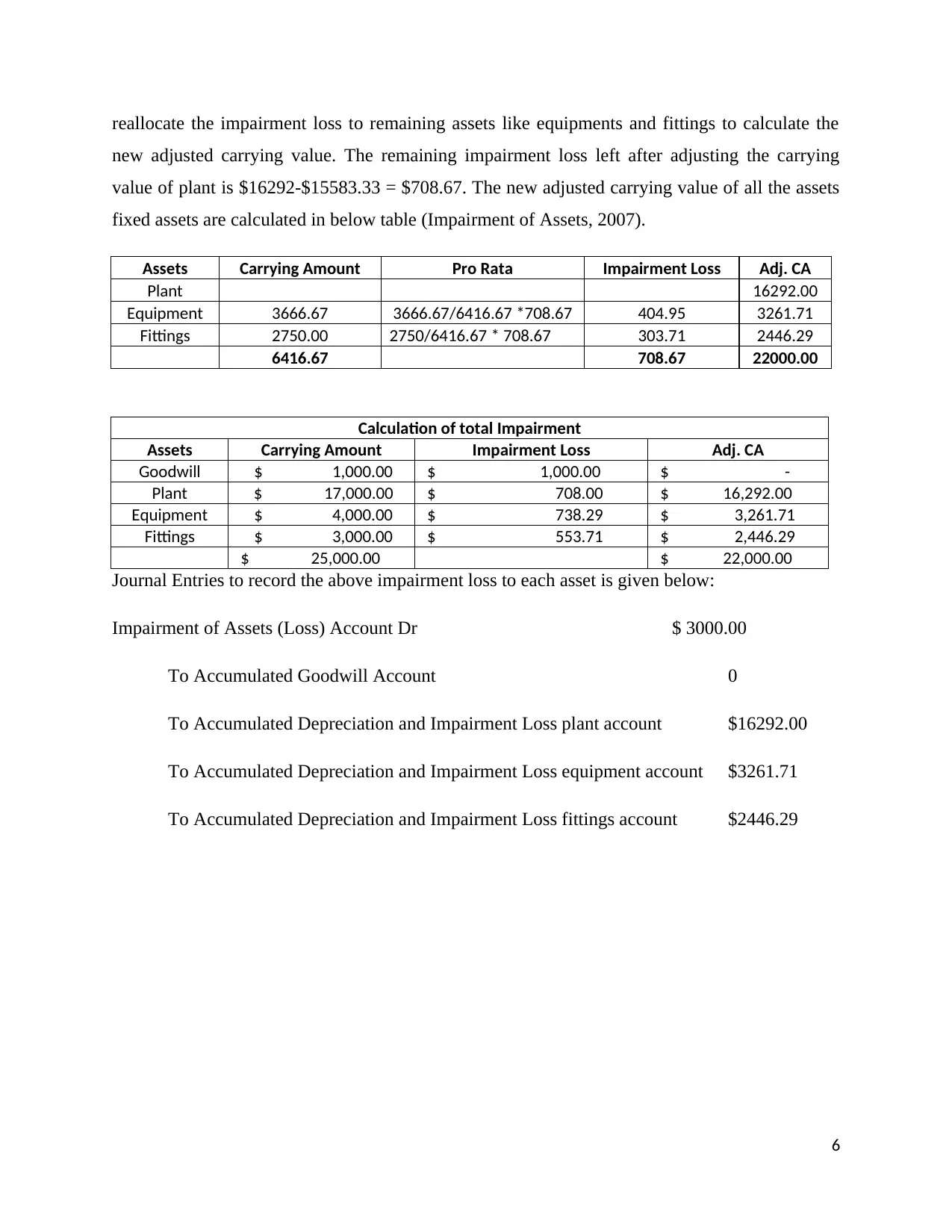
reallocate the impairment loss to remaining assets like equipments and fittings to calculate the
new adjusted carrying value. The remaining impairment loss left after adjusting the carrying
value of plant is $16292-$15583.33 = $708.67. The new adjusted carrying value of all the assets
fixed assets are calculated in below table (Impairment of Assets, 2007).
Assets Carrying Amount Pro Rata Impairment Loss Adj. CA
Plant 16292.00
Equipment 3666.67 3666.67/6416.67 *708.67 404.95 3261.71
Fittings 2750.00 2750/6416.67 * 708.67 303.71 2446.29
6416.67 708.67 22000.00
Calculation of total Impairment
Assets Carrying Amount Impairment Loss Adj. CA
Goodwill $ 1,000.00 $ 1,000.00 $ -
Plant $ 17,000.00 $ 708.00 $ 16,292.00
Equipment $ 4,000.00 $ 738.29 $ 3,261.71
Fittings $ 3,000.00 $ 553.71 $ 2,446.29
$ 25,000.00 $ 22,000.00
Journal Entries to record the above impairment loss to each asset is given below:
Impairment of Assets (Loss) Account Dr $ 3000.00
To Accumulated Goodwill Account 0
To Accumulated Depreciation and Impairment Loss plant account $16292.00
To Accumulated Depreciation and Impairment Loss equipment account $3261.71
To Accumulated Depreciation and Impairment Loss fittings account $2446.29
6
new adjusted carrying value. The remaining impairment loss left after adjusting the carrying
value of plant is $16292-$15583.33 = $708.67. The new adjusted carrying value of all the assets
fixed assets are calculated in below table (Impairment of Assets, 2007).
Assets Carrying Amount Pro Rata Impairment Loss Adj. CA
Plant 16292.00
Equipment 3666.67 3666.67/6416.67 *708.67 404.95 3261.71
Fittings 2750.00 2750/6416.67 * 708.67 303.71 2446.29
6416.67 708.67 22000.00
Calculation of total Impairment
Assets Carrying Amount Impairment Loss Adj. CA
Goodwill $ 1,000.00 $ 1,000.00 $ -
Plant $ 17,000.00 $ 708.00 $ 16,292.00
Equipment $ 4,000.00 $ 738.29 $ 3,261.71
Fittings $ 3,000.00 $ 553.71 $ 2,446.29
$ 25,000.00 $ 22,000.00
Journal Entries to record the above impairment loss to each asset is given below:
Impairment of Assets (Loss) Account Dr $ 3000.00
To Accumulated Goodwill Account 0
To Accumulated Depreciation and Impairment Loss plant account $16292.00
To Accumulated Depreciation and Impairment Loss equipment account $3261.71
To Accumulated Depreciation and Impairment Loss fittings account $2446.29
6
⊘ This is a preview!⊘
Do you want full access?
Subscribe today to unlock all pages.

Trusted by 1+ million students worldwide
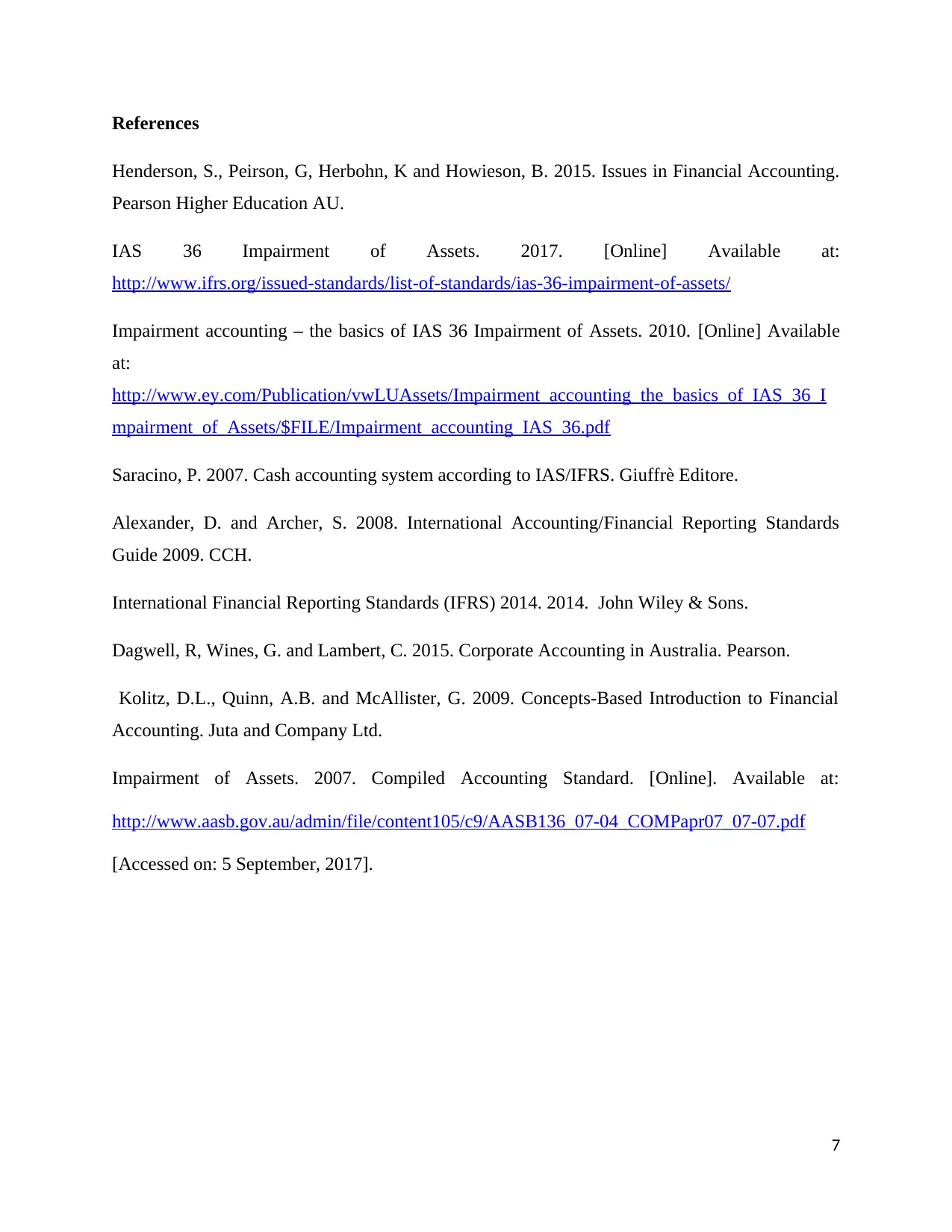
References
Henderson, S., Peirson, G, Herbohn, K and Howieson, B. 2015. Issues in Financial Accounting.
Pearson Higher Education AU.
IAS 36 Impairment of Assets. 2017. [Online] Available at:
http://www.ifrs.org/issued-standards/list-of-standards/ias-36-impairment-of-assets/
Impairment accounting – the basics of IAS 36 Impairment of Assets. 2010. [Online] Available
at:
http://www.ey.com/Publication/vwLUAssets/Impairment_accounting_the_basics_of_IAS_36_I
mpairment_of_Assets/$FILE/Impairment_accounting_IAS_36.pdf
Saracino, P. 2007. Cash accounting system according to IAS/IFRS. Giuffrè Editore.
Alexander, D. and Archer, S. 2008. International Accounting/Financial Reporting Standards
Guide 2009. CCH.
International Financial Reporting Standards (IFRS) 2014. 2014. John Wiley & Sons.
Dagwell, R, Wines, G. and Lambert, C. 2015. Corporate Accounting in Australia. Pearson.
Kolitz, D.L., Quinn, A.B. and McAllister, G. 2009. Concepts-Based Introduction to Financial
Accounting. Juta and Company Ltd.
Impairment of Assets. 2007. Compiled Accounting Standard. [Online]. Available at:
http://www.aasb.gov.au/admin/file/content105/c9/AASB136_07-04_COMPapr07_07-07.pdf
[Accessed on: 5 September, 2017].
7
Henderson, S., Peirson, G, Herbohn, K and Howieson, B. 2015. Issues in Financial Accounting.
Pearson Higher Education AU.
IAS 36 Impairment of Assets. 2017. [Online] Available at:
http://www.ifrs.org/issued-standards/list-of-standards/ias-36-impairment-of-assets/
Impairment accounting – the basics of IAS 36 Impairment of Assets. 2010. [Online] Available
at:
http://www.ey.com/Publication/vwLUAssets/Impairment_accounting_the_basics_of_IAS_36_I
mpairment_of_Assets/$FILE/Impairment_accounting_IAS_36.pdf
Saracino, P. 2007. Cash accounting system according to IAS/IFRS. Giuffrè Editore.
Alexander, D. and Archer, S. 2008. International Accounting/Financial Reporting Standards
Guide 2009. CCH.
International Financial Reporting Standards (IFRS) 2014. 2014. John Wiley & Sons.
Dagwell, R, Wines, G. and Lambert, C. 2015. Corporate Accounting in Australia. Pearson.
Kolitz, D.L., Quinn, A.B. and McAllister, G. 2009. Concepts-Based Introduction to Financial
Accounting. Juta and Company Ltd.
Impairment of Assets. 2007. Compiled Accounting Standard. [Online]. Available at:
http://www.aasb.gov.au/admin/file/content105/c9/AASB136_07-04_COMPapr07_07-07.pdf
[Accessed on: 5 September, 2017].
7
1 out of 7
Related Documents
Your All-in-One AI-Powered Toolkit for Academic Success.
+13062052269
info@desklib.com
Available 24*7 on WhatsApp / Email
![[object Object]](/_next/static/media/star-bottom.7253800d.svg)
Unlock your academic potential
Copyright © 2020–2025 A2Z Services. All Rights Reserved. Developed and managed by ZUCOL.





